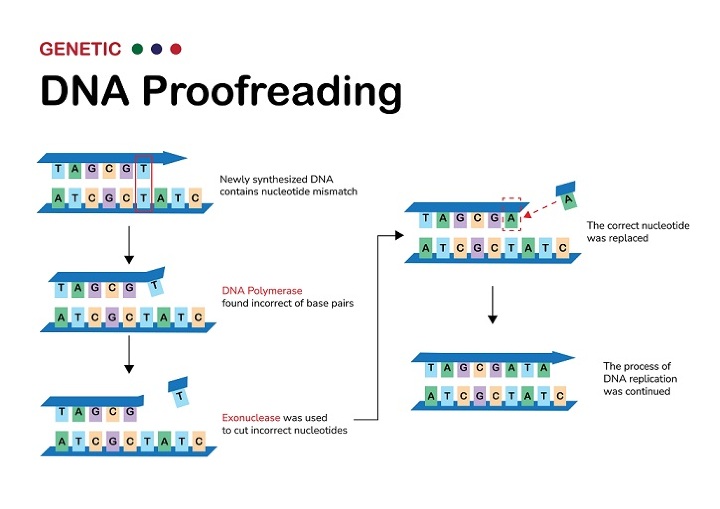
 Data Structure
Data Structure Networking
Networking RDBMS
RDBMS Operating System
Operating System Java
Java MS Excel
MS Excel iOS
iOS HTML
HTML CSS
CSS Android
Android Python
Python C Programming
C Programming C++
C++ C#
C# MongoDB
MongoDB MySQL
MySQL Javascript
Javascript PHP
PHP
- Selected Reading
- UPSC IAS Exams Notes
- Developer's Best Practices
- Questions and Answers
- Effective Resume Writing
- HR Interview Questions
- Computer Glossary
- Who is Who
What are Exonucleases and Discuss their Applications?
Introduction
Exonucleases are enzymes that cleave nucleotides from the end of DNA or RNA molecules. These enzymes are important for a wide variety of biological processes, including DNA replication, DNA repair, and RNA processing. In this article, we will discuss the properties of exonucleases and their applications in biotechnology and medicine.

Properties of Exonucleases
Exonucleases are a family of enzymes that are classified based on their substrate specificity and directionality. There are two types of exonucleases: 3'-exonucleases and 5'-exonucleases. 3'-exonucleases cleave nucleotides from the 3' end of the DNA or RNA strand, while 5'-exonucleases cleave nucleotides from the 5' end.
Exonucleases can be further classified based on their substrate specificity. Some exonucleases are specific for RNA, while others are specific for DNA. In addition, some exonucleases are specific for single-stranded nucleic acids, while others can cleave double-stranded nucleic acids.
Exonucleases are highly specific for their substrates and can only cleave nucleotides that are adjacent to the end of the nucleic acid strand. This specificity is important for preventing accidental degradation of intact nucleic acid molecules.
Applications of Exonucleases
Exonucleases have a wide range of applications in biotechnology and medicine. Here are some of the most common applications of exonucleases:
DNA sequencing: Exonucleases are used in DNA sequencing to remove the nucleotides from the end of the DNA strand. This allows for the identification of the nucleotide sequence in the DNA molecule.
RNA Processing
Exonucleases are important for RNA processing, which involves the modification and degradation of RNA molecules. 3'-exonucleases are involved in the degradation of mRNA, which is important for regulating gene expression.
PCR Cleanup
Exonucleases are used in PCR cleanup to remove any remaining primers or other contaminants from the PCR product. This helps to ensure that the PCR product is pure and accurate.
Gene Cloning
Exonucleases are used in gene cloning to remove the unwanted nucleotides from the ends of DNA fragments. This allows for the ligation of the DNA fragments to create a recombinant DNA molecule.
Restriction Enzyme Digestion
Exonucleases are used in restriction enzyme digestion to remove the nucleotides from the ends of the DNA molecule. This allows for the efficient binding of the restriction enzyme to the DNA molecule.
Next-generation sequencing library preparation: Exonucleases are used in next-generation sequencing library preparation to remove any adapter sequences or other contaminants from the DNA fragments. This helps to ensure that the sequencing data is accurate and reliable.
Antiviral Therapy
Exonucleases have been investigated as a potential antiviral therapy. Some viruses, such as herpesviruses, encode their own exonucleases, which are important for viral replication. Inhibiting these exonucleases can prevent the replication of the virus.
Site-directed Mutagenesis
Exonucleases can be used to create deletions or insertions in a DNA molecule to create specific mutations. By removing or adding nucleotides to the ends of the DNA molecule, the exonuclease can create a template that can be used for PCR amplification.
Enzyme-linked Immunosorbent Assay (ELISA)
Exonucleases are used in ELISA assays to remove any non-specific hybridization of DNA probes to the sample. The exonuclease can digest any unbound probes that are not specifically bound to the target molecule.
Nucleic Acid Labeling
Exonucleases can be used to remove the nucleotides from the end of a DNA or RNA molecule, allowing for the labeling of the remaining nucleotides. This labeled nucleic acid can then be used for various applications, such as in situ hybridization or microarray analysis.
DNA Repair
Exonucleases play a crucial role in DNA repair mechanisms. They are involved in the removal of damaged nucleotides from the DNA molecule, allowing for the repair of the DNA.
Conclusion
Exonucleases are important enzymes that play a critical role in DNA and RNA metabolism. These enzymes have a wide range of applications in biotechnology and medicine, including DNA sequencing, RNA processing, PCR cleanup, gene cloning, restriction enzyme digestion, next-generation sequencing library preparation, and antiviral therapy. The specific properties of exonucleases, such as their substrate specificity and directionality, make them useful tools for a variety of applications. As research into these enzymes continues, it is likely that additional applications for exonucleases will be discovered.
FAQs
Q1. What is the difference between 3'-exonucleases and 5'-exonucleases?
Ans. 3'-exonucleases cleave nucleotides from the 3' end of the DNA or RNA strand, while 5'-exonucleases cleave nucleotides from the 5' end.
Q2. What are the applications of exonucleases in biotechnology and medicine
Ans. Exonucleases have a wide range of applications in biotechnology and medicine, including DNA sequencing, RNA processing, PCR cleanup, gene cloning, restriction enzyme digestion, next-generation sequencing library preparation, and antiviral therapy.
Q3. What is the substrate specificity of exonucleases?
Ans. Exonucleases can be specific for RNA or DNA and can cleave single-stranded or double-stranded nucleic acids.
Q4. How are exonucleases used in DNA sequencing?
Ans. Exonucleases are used in DNA sequencing to remove the nucleotides from the end of the DNA strand, allowing for the identification of the nucleotide sequence in the DNA molecule.
Q5. What is the role of exonucleases in RNA processing?
Ans. Exonucleases are important for RNA processing, and 3'-exonucleases are involved in the degradation of mRNA, which is important for regulating gene expression.
Q6. Are there any potential medical applications for exonucleases?
Ans. Exonucleases have been investigated as a potential antiviral therapy, as inhibiting certain exonucleases can prevent the replication of some viruses.

